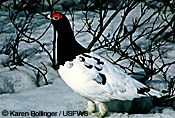Alaska Fish & Wildlife News
January 2004
White for Winter
Seasonal Camouflage Handy in Alaska

We humans shed twice a year like most mammals, and our hair turns white like some foxes, weasels and lemmings do in winter. But our seasonal cycles are much less pronounced, and it's age, not the need for camouflage, that triggers our color change.
A white coat against winter snow is the next best thing to invisibility, and that's important for predators and prey. Arctic foxes are both. They hunt voles and lemmings, and in the high Arctic they trail after polar bears and glean scraps from ...
White for Winter ArticleContinued
Alaska's Great Blue Herons

On a winter morning, a great blue heron stalked the tidal flats at the mouth of Gold Creek in Southeast Alaska. Wading carefully, the tall bird didn't make a single ripple in the shallow water. It paused, then plunged its dagger-like bill underwater and pulled out a wriggling fish.
While many birds leave Alaska in the fall, some great blue herons stick around, wintering in Southeast and fishing the wetlands and shorelines. Alaskans know the great blue heron as a superb fish catcher, but ...
Herons ArticleContinued
Gustavus Moose Population
Moose outnumber residents by 2 to 1

Do you live in a community where moose outnumber people? For the winter residents of Gustavus the answer is a resounding "Yes!"
In fact, there are about twice as many moose living on the Gustavus forelands this winter as there are human inhabitants. This hasn't always been the case, however, as moose have been known to occur in this area only for the last 40 years or so.
Gustavus, a small community about 40 miles west of Juneau, borders Glacier Bay National Park. In 1958, ...
Gustavus Moose ArticleContinued
